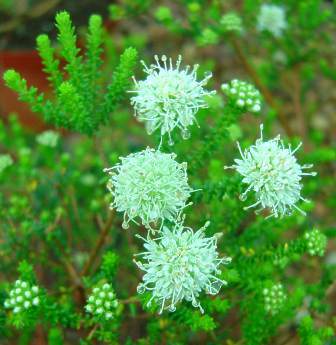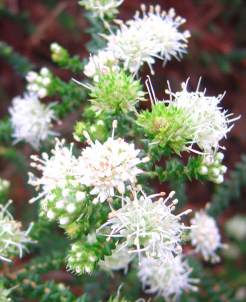Agathosma gonaquensis
Agathosma gonaquensis Eckl. & Zeyh.
Family: Rutaceae
Common names: Gonaqua buchu (Eng.), Hottentotsboegoe (Afr.)
Introduction
This leafy shrub is compact, low-growing and displays masses of white flowers during spring. The oil glands found on the leaves and fruit release a sweet to pungent scent when crushed, which is a common characteristic of the buchu family.

Description
Description
Agathosma gonaquensis is a single-stemmed, slow-growing, evergreen shrub, reaching a height of 0.5-1 m. It has a spreading habit, and a rounded shape. The leaves are small, dark green 6-9 mm long, crowded and alternately arranged on the stems.
The flower heads consist of 1-12 white flowers packed into dense, rounded heads measur ing 5 mm in diameter. The flowering season is late winter, spring to midsummer (July until December).

The fruit has a three-chambered seed capsule with one shiny black seed in each chamber. The seed capsule turns from green to brown as it matures. The seed is released and scattered over a distance (known as ballistic dispersal or catapult mechanism).
Conservation Status
Status
Agathosma gonaquensis is Critically Endangered (CR). Herbarium records show that this species was once common around Port Elizabeth. Today, only two small and severely fragmented subpopulations survive. Most of its habitat has been destroyed by urban development. The wild population continues to decline due to alien plants invading what remains of its habitat, and ongoing urban development.
Distribution and habitat
Distribution description
Agathosma gonaquensis occurs naturally in coastal grassland with fynbos elements, from Uitenhage to Port Elizabeth in the Eastern Cape. The genus Agathosma consists of 150 species found mainly in the Western Cape.
Derivation of name and historical aspects
History
Agathosma is derived from the Greek word agathos meaning pleasant, and osme meaning scent, and refers to the fragrant oil glands on the leaves and fruit. The species name is derived from the Gonaqua, a group of Khoikhoi-Xhosa, who inhabited the area inland of Algoa Bay where this species occurs.
Ecology
Ecology
Flowering bushes attract bees, butterflies and other insects, which pollinate the flowers. Seed is often found at the base of the shrub and carried away by ants.
Uses
Use
Agathosma betulina (round leaf buchu) and Agathosma crenulata (long leaf buchu) are commercially grown for their oil content. The oil is used in the manufacturing of cosmetics, soaps and medicinally for its antiseptic and diuretic properties.
Buchus such as Agathosma glabrata, A. lanceolata (honey buchu) and A. ovata 'Kluitjieskraal'. can be used in any garden as fillers, in a mixed fynbos bed or in a herbaceous border.
This buchu is tough and can withstand dry, sandy and windy conditions. An ideal plant for coastal gardens, it can be planted in terra force walls and on embankments to stabilize soil.
Traditionally, Agathosma qonaquensis is used as an infusion for hay fever and colds.

Growing Agathosma gonaquensis
Grow
Buchus can be successfully grown from seed or cuttings. Seed harvested for sowing should not be picked too early, as the embryo is not fully developed. Seed will not be viable and germination percentage will be low. Do a test by pressing the seed capsule between your fingers. If it feels hard and not soft and it is dark green or brown, it is ready for picking. The capsules disperse the seeds explosively, so place seed capsules in a closed paper bag for drying and storage.
Seed ripens in summer (October to December). Fresh buchu seed is sown in autumn (March to April). The seeds are sown into a tray containing a well-drained medium of equal portions of sand, loam and compost. Use some of the medium to cover the seed and water. Place in a covered area with good light and air circulation. Keep medium-damp. Germination occurs in one to two months.
Young seedlings are pricked out into 0.5 l bags when four true leaves have developed. Use a medium suitable for fynbos. Feed plants regularly but sparingly with a well-balanced fertilizer. Pinch out the growing tips of the seedlings to encourage bushy growth. Flowers are produced after two years.
Cuttings After flowering, plants develop new shoots or branches, which are ideal for tip, stem or heel cuttings. Collect plant material early in the morning to reduce stress. Cuttings have the advantage of producing a larger flowering plant quicker than seedlings. Tip cuttings, 50-70 mm, are taken from the current year's growth. Prepare cuttings by making a clean cut below the node and remove a third of the foliage. Dip the base of the cutting in a rooting hormone. Firmly place the cuttings in a medium of 50% bark and 50% polystyrene and water cuttings with a fungicide. Ideally these cuttings should now be placed in a well-aerated propagation unit with a bottom heat of 24ºC. Rooting occurs in 9 to 11 weeks. Carefully pot the rooted cuttings using a well-drained, humus-rich, fynbos potting medium (2 parts leaf mould, 1 part coarse sand). Plants will be ready for planting in 7 to 8 months, ideally during autumn to spring. Feed regularly with a well-balanced nutrient. Yellow leaves can be treated with an application of iron chelate.
Cultivation Agathosma gonaquensis is best planted into the garden during autumn, winter and spring. The rainy season allows buchus to establish themselves in the garden and to cope with drought and less water during summer. Once established they will withstand a fair amount of frost. Plant buchus in your garden where they will receive full sun, in soil that is alkaline to acid, well drained and composted. Before planting, prepare the garden bed by digging over the soil, adding compost and a slow-release fertilizer. Water the garden area before planting. Plant them with medium-sized plants, in groups of 3, 5 or 9, 20-30 cm apart, with enough space to encourage growth. Water well after planting. Plants require good watering in winter and moderate watering in summer. Do not allow plants to dry out and avoid cultivating the soil around the roots of these fynbos plants. They are slow-growing plants and should not be planted too close to faster growing plants. A layer of mulch is added after planting and annually to keep soil and roots cool in summer. Mulch retains soil moisture and reduces germination of weed seeds.
Agathosma qonaquensis, as well as most of species found in Rutaceae family, are water-wise. The Gonaqua buchu can be used as an accent plant in a mixed fynbos bed or in a coastal garden with companion plants such as Leucospermum cordifolium (pincushion), Protea neriifolia (oleander leaf protea), Erica patersonii (mielie heath), Elegia tectorum (Cape thatching reed) and herbaceous perennials such as Felicia aethiopica, Leonotis leonurus (wild dagga), and Dietes bicolor (yellow wild iris). Buchus provide colour, fragrance and attract insects to the garden. Interplant with other interesting buchu species such as Acmadenia heterophylla, Adenandra uniflora (china flower), Agathosma mucronulata (false buchu) and Diosma prama. It is suitable in a rockery in between rocks or used as a container plant.
References
- Gold, M. 1992. The buchus: cultivation and propagation. National Botanical Institute, Kirstenbosch, Cape Town.
- Goldblatt, P. & Manning, J. 2000. Cape plants. A conspectus of the Cape flora of South Africa. Strelitzia 9. National Botanical Institute, Pretoria & Missouri Botanical Garden, Missouri.
- Manning, J. 2001. Eastern Cape.South African Wild Flower Guide 11. Botanical Society of South Africa, Cape Town.
Credits
Norma Jodamus
Kirstenbosch NBG
September 2006
(Updated by Alice Notten September 2010)
Plant Attributes:
Plant Type: Shrub
SA Distribution: Eastern Cape, Western Cape
Soil type: Sandy, Loam
Flowering season: Spring, Early Summer
PH: Acid
Flower colour: White
Aspect: Full Sun, Afternoon Sun (Semi Shade)
Gardening skill: Average
Special Features:
Horticultural zones








Rate this article
Article well written and informative
Rate this plant
Is this an interesting plant?
Login to add your Comment
Back to topNot registered yet? Click here to register.